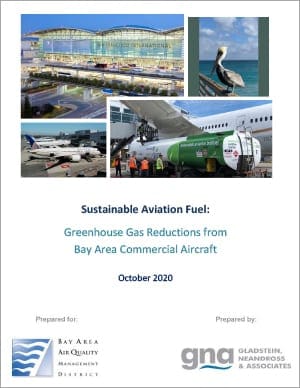
Sustainable Aviation Fuel: Greenhouse Gas Reductions from Bay Area Commercial Aircraft
Published October 2020
Client: Bay Area Air Quality Management District
Abstract
Sustainable aviation fuel (SAF) is a drop-in replacement for conventional jet fuel (CJF) that can significantly reduce full-fuel-cycle greenhouse gas (GHG) emissions from jet aircraft engines. Currently, SAF is required to be blended with CJF at up to 50 percent SAF by volume. Of the seven certified processes to produce SAF, one pathway (hydroprocessing of esters and fatty acids, or HEFA) currently accounts for more than 95 percent of the SAF used in commercial aviation. Neat SAF produced using the HEFA process currently reduces full-fuel-cycle GHG emissions from jet aircraft by approximately 60 percent compared to using baseline CJF. SAF that will be available in the near future (from HEFA or other pathways) will likely provide even greater GHG-reduction benefits.
The world’s commercial aviation sector contributes roughly two-to-three percent of combustion-related GHG emissions. In California’s Bay Area (greater San Francisco-Oakland), aviation contributes about six percent of transportation-related GHG emissions. Compared to surface (ground and water) transportation modes, the aviation sector presents greater challenges to decarbonize. Commercial aviation companies have made important strides to reduce carbon emissions through aircraft fleet efficiency improvements, but SAF has emerged as the leading approach to further reduce GHG emissions from jet aircraft.
There are currently four LCFS-certified “pathways” to produce SAF; all four use the HEFA process and animal tallow feedstock at World Energy’s biorefinery in Paramount, CA. These pathways provide full-fuel-cycle GHG reductions ranging from 52 to 73 percent relative to baseline CJF. Although SAF must currently be blended with CJF (having higher carbon intensity), each SAF gallon ultimately displaces one CJF gallon and therefore provides GHG reductions based on the relative carbon intensities of the two neat fuels.
SAF blends can also improve local ambient air quality, especially within airport boundaries and adjacent areas in close proximity to large numbers of jet “Landing and Take Off” (LTO) events. Specifically, SAF blends can significantly reduce direct aircraft emissions of fine particulate matter (PM), sulfur oxides (SOx), and carbon monoxide (CO). Although more studies are needed, displacing neat CJF with SAF blends also appears to reduce black carbon emissions and provide beneficial alterations of ultrafine particle emissions from jet engines. Based on studies to date, it appears that SAF does not significantly change NOx emissions from the jet engines, and therefore it does not seem to advance ozone-reduction strategies in the Bay Area or other urban areas.
